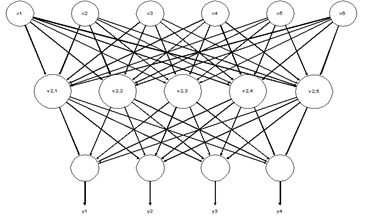The main advantage to a system’s engineering approach is the ease with which it can be automated. Various inputs and formula can become inputs into a neural network algorithm (Fig. 1). Equations for insurance, risk, TSPs (Travelling Salesman problems), and more could be modelled in three layers (Fig 2).
A node can act as a perceptron. The vote or firing sequence is based on the use of a threshold and address. These can be extended to PSO (Particle Swarm Optimised) code and genetic algorithms, when the node is also funded using Bitcoin (or another currency). The inputs use the patent-№479 threshold system and send signed transactions to the next layer based on external input or other events. This can be:
- On block
- CPFP (Child Pays for Parent) chained transactions.
Here, an input layer with one neuron for each input (system or application) could be used to map for IP options, malware, and buffer overflow conditions, selected attacks, etc. The system of perceptrons would be processed using a hidden neuron layer in which each neuron represents combinations of inputs and calculates a response based on current data coupled with expected future data, a prior data, and external systems data. Data processed at this level would feed into an output layer. The result of the neural network would supply the output as an economic risk function.
This could also form the basis of any number of External AI or Expert Systems.
In this way, a risk function or Derivative Free Optimised Formula can be created that not only calculates data based on existing and known variables, but also updates automatically using external sources and trends. Many external sources have become available in recent years that provide external trending and correlation points. Unfortunately, most of these services have clipped data as the determination of an attack is generally unclear and takes time to diagnose where much otherwise useful data is lost. When monitoring the operation of a system or the actions of uses, thresholds are characteristically defined above or below which alerting, alarms, and exceptions are not reported. This range of activity is regarded as baseline or routine activity.

Multi-Layer layer topology neural networks can be used to accept data from risk models and automatically update the risk profile of an organisation. In modelling risk, each application and system can be modelled using a perceptron.
These can also be used as control point for IoT devices and any other agent-based system. The blockchain allows for auditing of the system and the ability to validate the inputs and ensure the integrity of the system.

The perceptron is the computational workhorse in this system. In this it is reasonable to model the selected risk factors for the system and calculate a base risk that is trained and updated over time. The data from multiple organisations can be fed into a decentralised system that can be distributed to all users. This could be integrated and sold as a product enhancement by existing vendors or independent third parties could maintain external data-sets.

A large vendor such as Microsoft could create an implementation model.
The training of the network would require the determination of the correct weights for each neuron. This is possible in selected systems, but a far larger effort would be required to enable this process for more generalised deployment. The data needed for such an effort already.

